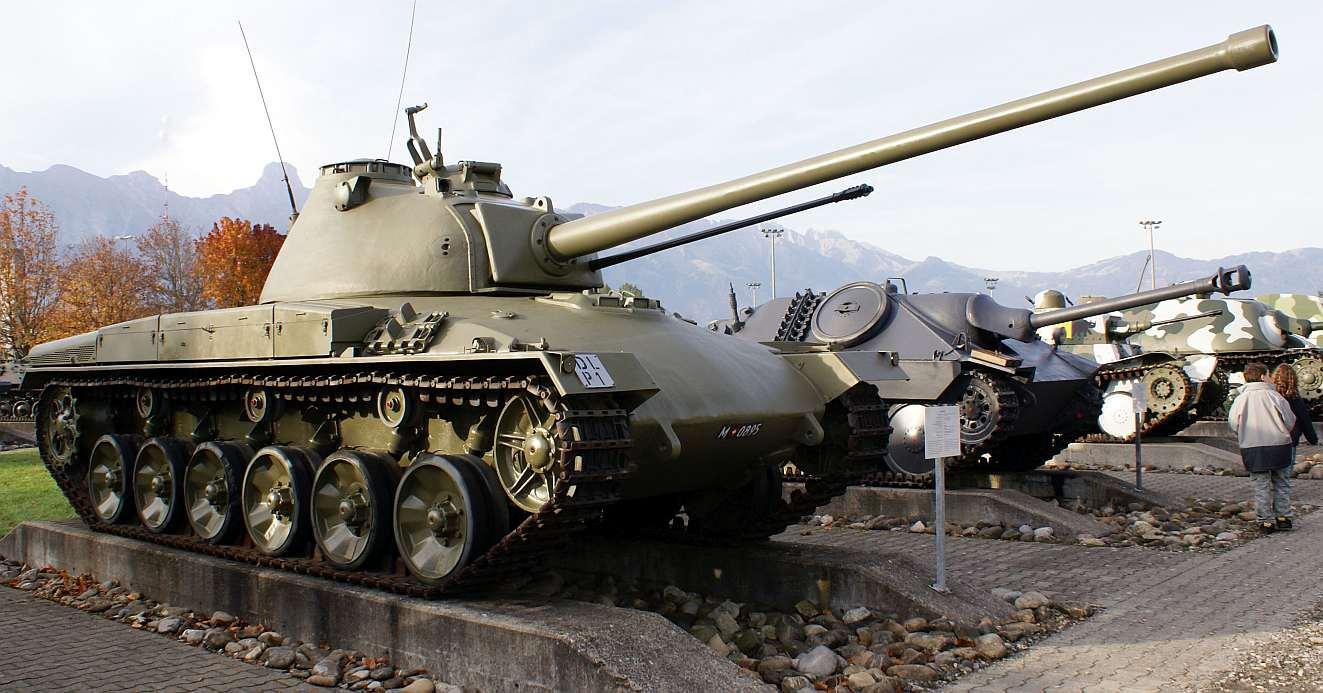Mittlerer Panzer 58
Source – http://yuripasholok.livejournal.com/4484665.html
For a variety of reasons (mainly economic) Switzerland for a long time bought armored vehicles from other countries. The situation changed in the 50s. It is no secret that Swiss companies (especially Oerlikon and Solothurn) cooperated actively with the Germans before the Second World War. After the war, Switzerland continued cooperation. In 1953, a group of German companies, Porsche, Daimler-Benz, Zahnradfabrik Friedrichshafen AG and Ruhrstahl began the design of a medium tank for India. A medium tank of 30tons under the name of Indien-Panzer had to be produced at the facilities of the Indian Tata.
Per una serie di motivi (soprattutto economici) la Svizzera per lungo tempo acquistava veicoli corazzati da altri paesi. La situazione cambiò negli anni ’50. Non è un segreto che le imprese svizzere (soprattutto Oerlikon e Solothurn) cooperassero attivamente con i tedeschi prima della Seconda Guerra mondiale. Dopo la guerra, continuò la cooperazione anche in ambito bellico. Nel 1953, un insieme di aziende tedesche, Porsche, Daimler-Benz, Zahnradfabrik AG di Friedrichshafen e Ruhrstahl iniziarono la progettazione di un carro medio per l’India. Un carro medio da 30 tonnellate con la denominazione di Indien-Panzer doveva essere prodotto presso le strutture dell’indiana Tata.
Even Swiss companies were involved in the development of Indien-Panzer. The projects of the tank were ready in 1954, but the customer rejected them. The vehicle was good but the Tata didn’t have industries suitable for production and India chose the path of Switzerland, buy foreign vehicles. The story does not end here. In 1956, the Germans launched the project Europanzer, who was a 30-ton MBT. It was an evolution of Indien-Panzer that led to the birth of tanks as Leopard I and AMX-30.
Anche le aziende svizzere parteciparono allo sviluppo dell’Indien-Panzer. I progetti del carro erano pronti nel 1954, ma il cliente li respinse. Il carro era buono ma la Tata non aveva industrie adatte alla produzione e l’India scelse la via della Svizzera, acquistare carri esteri. La storia non finisce qui. Nel 1956, i tedeschi lanciarono il progetto Europanzer, che era un MBT da 30 tonnellate. Fu un’evoluzione dell’Indien-Panzer che portò alla nascita di carri armati come Leopard I e AMX-30.
In the same period in which there was the development of Indien-Panzer, Switzerland began development of its own tank, codenamed KW.30 or Kampfwagen 30, class 30tons. The Eidgenoessische Konstruktionswerkstaette (EKW) Thun engaged in the development of KW.30. As expected, the 30-ton class tank was equipped with a 90 mm cannon of its own design (9 cm Kanone 48), the engine is thought to be the same dell’Indien-Panzer: Mercedes Benz Type 837
Nello stesso periodo in cui vi fu lo sviluppo dell’Indien-Panzer, la Svizzera iniziò lo sviluppo di un proprio carro, nome in codice KW.30, cioè Kampfwagen 30, classe da 30 tonnellate. La Eidgenoessische Konstruktionswerkstaette (EKW) di Thun si impegnò nello sviluppo del KW.30. Come previsto, il carro classe 30 tonnellate era equipaggiato con un cannone da 90 mm di propria progettazione (9 centimetri Kanone 48), il motore si pensa fosse lo stesso dell’Indien-Panzer: Mercedes Benz Tipo 837
KW.30 prototype was completed in 1957 and two years later was to begin the mass production. It was built a second prototype, the Mittlerer Panzer 58 (or Panzer 58), which gave the designation to the entire serie, armed with English 84-mm (20 pounds), also produced in Switzerland (called 8.4 cm Panzerkanone 58) . The second prototype received a 20mm automatic coaxial cannon named Oerlikon (hereinafter 20mm Panzerkanone 61). The number of wheels was brought to 6. This vehicle is preserved in Panzermuseum of Thun. After the tests, 10 Panzer 58 pre-series were ordered, equipped with 105 mm cannons, 10.5 cm Panzer Kanone 60. Later, these 10 pre-series were converted to Panzer 61. 160 Pazer 61 were built.
il prototipo KW.30 è stato realizzato nel 1957 e due anni dopo doveva iniziare la produzione in serie. Venne costruito un secondo prototipo, il Mittlerer Panzer 58 (o Panzer 58), che ha dato la designazione a tutta la serie, dotato di 84-mm (20 libbre) inglese, prodotto anche in Svizzera ( denominato 8,4 cm Panzerkanone 58). Il secondo prototipo alla mitragliatrice coassiale MG 51 Panzer 58 ricevette un cannoncino 20mm automatico Oerlikon (in seguito 20mm Panzerkanone 61). Il numero delle ruote venne portato a 6. Questo veicolo è conservato nel Panzermuseum di Thun. Dopo le prove vennero ordinati 10 Panzer 58 pre-serie, dotati di cannoni da 105 mm, 10,5 cm Panzer Kanone 60. In seguito, questi 10 carri pre-serie vennero convertiti in Panzer 61, di cui in totale vennero ne costruiti 160.




















